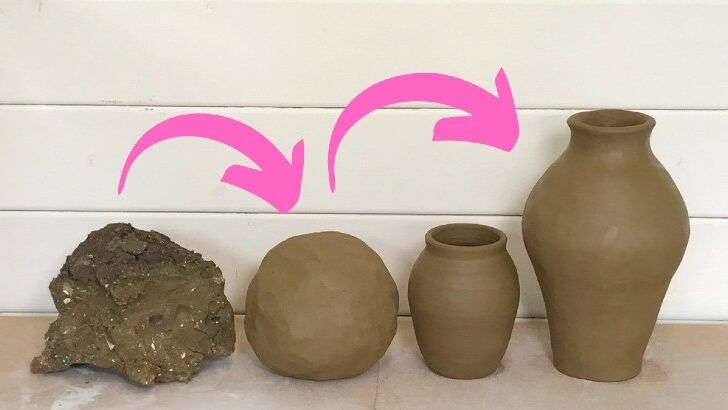Which Material Is Good For Ganesh Idol?
Ganesh or Ganesha, the elephant-headed deity, is one of the most revered Gods in Hinduism. He is the son of Lord Shiva and Goddess Parvati and is widely worshipped as the remover of obstacles, the patron of arts and sciences, and the personification of wisdom and intelligence. Idol worship is an integral part of Hinduism, and hence Ganesh idols are found in most Hindu homes and temples. These idols are made from different materials based on traditions and individual preferences. The practice of installing Ganesh idols has become extremely popular during the annual Ganesh Chaturthi festival where thousands of idols are created and worshipped.
Clay
Clay is one of the most commonly used materials for making Ganesh idols. There are several types of clay that can be used:
Terracotta Clay – This is natural reddish clay that is inexpensive and readily available. It’s easy to mold but prone to breakage when dry.
Potter’s Clay – A refined and homogenized clay that fires to a light color. It’s smooth, flexible, and great for sculpting detail.
Polymer Clay – A man-made clay that air-dries smoothly and doesn’t require firing. It comes in various colors but can be fragile.
Earthen Clay – A natural clay dug from the earth and mixed with water. It air-dries hard and is very affordable and accessible.
Clay gives artisans a lot of flexibility to sculpt idols in any shape and size. With the right sealants, clay idols can be made water-resistant. The main downside is their fragile nature and need for careful handling.
Plaster of Paris
Plaster of Paris, also known as gypsum plaster, is one of the most popular materials used for making Ganesh idols. Here are some of the properties that make it highly suitable for this purpose:
Easy to mold: Plaster of Paris is obtained by heating gypsum or calcium sulfate dihydrate. When mixed with water, it forms a paste that sets into a hard porous mass. The setting time can be controlled by regulating the amount of water added. This makes it easy to mold into the desired idol shapes.
Smooth finish: On drying, Plaster of Paris gives a very smooth and glassy finish to the idols. This makes the idols look beautiful and appealing. Intricate details and patterns can be crafted on the idols using molds.
Lightweight: Idols made of Plaster of Paris are lightweight as compared to those made from clay or cement. This makes it convenient to carry the idol for visarjan or immersion.
Easy availability: Plaster of Paris is easily available in the market at affordable rates. Artisans don’t need to source any specialty materials.
Adds strength: When mixed with paper pulp or cloth pieces, Plaster of Paris makes a hard papier-mâché-like material that has good strength. This allows making large idols.
Papier Mache
Papier mache is a lightweight alternative for making Ganesh idols. It involves using paper strips or shreds soaked in glue and water, which are then molded over a structure to form the shape of the idol. Once dried, papier mache can be painted and decorated elaborately.
The advantages of using papier mache for Ganesh idols include:
- It is very lightweight, making the idols easy to carry for immersion.
- Papier mache is inexpensive and easy to work with.
- Intricate details and decorative elements can be created on the idols using papier mache techniques.
- Bright colors can be painted on papier mache idols to make them more vibrant.
- The idols are eco-friendly as they dissolve completely in water during immersion.
However, papier mache idols need to be handled carefully as they can tear or come apart since they are fragile. Overall, papier mache is a creative and eco-friendly option for making lightweight Ganesh idols.
Wood
Wood is a commonly used material to make Ganesh idols, especially in rural households and communities. The types of wood used include:
- Sandalwood – Known for its aromatic fragrance and smooth texture, sandalwood makes for aesthetically pleasing idols.
- Rosewood – A hardwood like teak, rosewood is durable and can be finely carved into intricate patterns and details.
- Deodar – The ‘divine tree’ in Sanskrit, deodar wood is lightweight yet sturdy. It is also termite-resistant.
- Basswood – With a soft texture that’s easy to sculpt, basswood allows artisans to carve delicate and detailed features into the idol.
- Birch – Birch has a fine grain that takes paint and varnish nicely. The wood can portray finer details.
Artisans prefer woods like sandalwood and rosewood for their aroma, texture, strength and carvability. Lightweight woods like deodar and basswood also work well for sculpting idols.
Metal
Metal is considered a premium and special material for making Ganesh idols. Metals commonly used are bronze, brass, copper and iron. Each metal lends a unique look and feel to the idol.
Bronze is an alloy made of mainly copper and tin. Bronze Ganesh idols have an antique golden sheen and intricate detailing can be carved into them. Bronze is more expensive but is highly durable and ages beautifully.
Brass is an alloy of copper and zinc. It has a bright golden color that shines through spiritual motifs engraved on the idol. Brass idols look grand and are corrosion resistant.
Copper idols have a warm reddish-brown tone. Copper is malleable allowing artisans to hand-hammer the fine details. With time, the copper acquires an antique greenish patina making the idol look vintage.
Wrought iron is weather resistant and can be crafted into delicate ornamental idols with floral motifs. Iron lends a traditional, rustic appeal.
Stone
Stone is a popular material for making Ganesh idols, especially types of stone like granite and marble. Granite is an igneous rock that is extremely hard and durable. When polished, granite takes on a glossy shine. The natural colors and patterns of granite can make for very striking and unique Ganesh idols.
Marble is a metamorphic rock made from limestone that has been subjected to immense heat and pressure. It is less durable than granite, but is still hard and can be highly polished. Pure white marble is especially popular for Ganesh idols as it has a bright, clean aesthetic. However, marble comes in many colors and patterns that can also be utilized.
The main downside of stone idols is their weight. Large granite or marble Ganesh idols can be extremely heavy and difficult to transport. Care must also be taken to securely fasten the parts of a stone idol together. However, stone is one of the most venerable and traditional materials used for Hindu idols given its natural beauty, durability, and availability in India.
Glass
Glass is a unique and beautiful material that can be used to create stunning Ganesh idols. Fused glass, in particular, allows artisans to form glass pieces of various colors and textures into an idol. The glass is heated in a kiln, fusing the separate pieces into one solid form.
Fused glass Ganesh idols have an eye-catching and modern appearance. The see-through nature of the glass allows light to pass through the sculpture, creating a magical glow. Colorful glass pieces in shades of yellow, orange, red, green, blue and more can be incorporated to reflect Ganesh’s vibrant and joyful nature.
One major advantage of glass is its durability. Unlike clay or plaster idols that can chip, crack or break easily, glass is strong and withstands damage well. A fused glass Ganesh idol can become a family heirloom passed down over generations. With care and cleaning, the colors will remain vibrant for years.
However, glass idols are heavier than other materials and the production process is more complex. The glass working must be done by a skilled artisan and then the idol transported carefully. Set up of a glass Ganesh also requires a stable base or platform.
Overall, fused glass allows for stunning and long-lasting Ganesh idols that add grace and radiance to any home or temple. The sheer beauty of the translucent, glowing glass infused with rich colors makes it a wonderful alternative to traditional materials for Ganesha sculptures.
Comparative Analysis
When choosing the material for making a Ganesh idol, each material has its own pros and cons to consider:
Clay:
Pros: Clay is inexpensive and easy to mold into any shape. It’s also an eco-friendly traditional material choice.
Cons: Clay is fragile, heavy, and needs to be reapplied each year. It can crack during the Ganpati festival.
Plaster of Paris:
Pros: POP sets quickly and gives a smooth, finished look. It’s also lightweight.
Cons: Non-biodegradable and toxic chemicals are released when painted. Each year leads to more waste.
Papier Mache:
Pros: Papier mache is lightweight, easy to paint, and inexpensive. It’s a creative option.
Cons: Not as durable as other materials and can’t withstand heavy rains.
Wood:
Pros: Natural material that can be reused and recycled. Withstands weather well.
Cons: Heavier and takes more effort to carve intricately. Not always eco-friendly if rare woods are used.
Metal:
Pros: Very durable and withstands weather and damage. Can create intricate details.
Cons: Heaviest material, difficult to transport. Expensive and not eco-friendly.
Stone:
Pros: Natural, eco-friendly, and durable material. Withstands weather well.
Cons: Very heavy and difficult to sculpt intricately. Expensive option requiring skilled artisans.
Glass:
Pros: Intricate details and colorful effects possible. Durable material.
Cons: Heavy, expensive, high risk of damage during transport and rituals. Not eco-friendly.
Conclusion
When selecting the ideal material for a Ganesh idol, there are several factors to consider including cost, durability, weight, environmental impact, and ease of use. Based on these criteria, the best all-around options seem to be clay, plaster of Paris, and papier mache.
Clay is very affordable, easy to mold, relatively lightweight, and eco-friendly. Air-drying clay in particular does not require firing so the idols can be easily dissolved in water after use. The main downsides are that clay idols are fragile and may crack or chip during transport or immersion.
Plaster of Paris is also inexpensive and simple to work with. Once dried, the idols are fairly durable for the duration of the festival. Plaster can be painted in vibrant colors and molded into intricate shapes. The main environmental concern is that plaster does not dissolve well, so the idol remnants must be carefully collected from the water.
Papier mache involves shaping paper pulp around a clay or wire frame. It is one of the lightest options and can be decorated with paint, sequins, flowers, and other embellishments. Since the paper is biodegradable, papier mache idols have minimal environmental impact when immersed. The main drawback is these idols get soaked during immersion and may come apart.
Based on cost, availability, environmental friendliness, and practical considerations, clay, plaster of Paris, and papier mache seem to be the best materials for Ganesh idols for most situations. With proper care and handling, they can make beautiful, ecologically responsible idols for the celebration.


